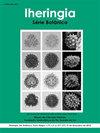Variação na altura e na abundância de colmos e estruturas reprodutivas em populações pioneiras e maduras de Spartina alterniflora Loisel. e S. densiflora Brongn. ( Poaceae ) do sul do Brasil
IF 0.4
4区 生物学
Q4 Agricultural and Biological Sciences
引用次数: 0
Abstract
This study aimed to quantify and elucidate the spatial variability of plant height and abundance of tillers and reproductive structures of the salt marsh grasses Spartina alterniflora Loisel. and Spartina densiflora Brongn. within and between pioneer ( 50 years of colonization) in southern Brazil. Both pioneer populations had taller tillers (p<0.01) than mature populations. Pioneer populations of S. densiflora also showed massive investment on tiller density (10,084 m-2), more infl orescences (557 m-2) and higher fecundity (16,258 seeds m-2) than the mature population (131 infl orescence m-2; 2,199 seeds m-2). High redox and reduction of phosphorus availability in the sediment away from the water line seem to explain decreasing densities of tiller and infl orescences inside S. densiflora mature populations. Fourteen percent of pioneer S. alterniflora tillers flowered and, on average, produced only 0.4 seeds per infl orescence and 76 seeds m-2, whereas mature population did not fl ower.互叶草先锋和成熟种群茎高、茎丰度和生殖结构的变化。它是一种非常罕见的植物。(禾本科)产于巴西南部
本研究旨在量化和阐明互花米草(Spartina alternniflora Loisel)株高、分蘖丰度和生殖结构的空间变异。和米草属。在巴西南部的拓荒者(50年的殖民)内部和之间。两个先驱者群体分蘖均高于成熟群体(p<0.01)。在分蘖密度(10,084 m-2)、花序数(557 m-2)和繁育力(16,258粒m-2)方面,先民群体也表现出比成熟群体(131粒花序m-2)更大的投入;2199粒(m-2)。远离水线的沉积物中高氧化还原和磷有效性的降低似乎解释了密草成熟种群中分蘖和花序密度的下降。14%的互花蓟马先驱者开花,平均每个花期只产生0.4粒种子,m-2只产生76粒种子,而成熟群体不开花。
本文章由计算机程序翻译,如有差异,请以英文原文为准。
求助全文
约1分钟内获得全文
求助全文
来源期刊

Iheringia Serie Botanica
PLANT SCIENCES-
CiteScore
0.70
自引率
0.00%
发文量
22
审稿时长
>12 weeks
期刊介绍:
The Iheringia, Série Botânica is a publication edited by the Museu de Ciências Naturais, Fundação Zoobotânica do Rio Grande do Sul, since 1958. The name Iheringia is actually a tribute to Hermann von Ihering (a German researcher who became a Brazilian citizen) and his important studies in the Natural Sciences.The journal has the mission of publishing articles, reviews and original scientific notes that cover diverse areas in Botany, and may be written in Portuguese, Spanish and English.
The journal is widely available in both international and national scientific community. The issues are published and distributed twice a year to 118 national institutions and 152 international institutions. The distribution is either free of charge or by exchange.
Impac Factor JCR 2014/2015 = 0.263
Qualis CAPES 2015: B 4 (Biodiversity) B1 (Agricultural Science I) B1 (Environment)
 求助内容:
求助内容: 应助结果提醒方式:
应助结果提醒方式:


